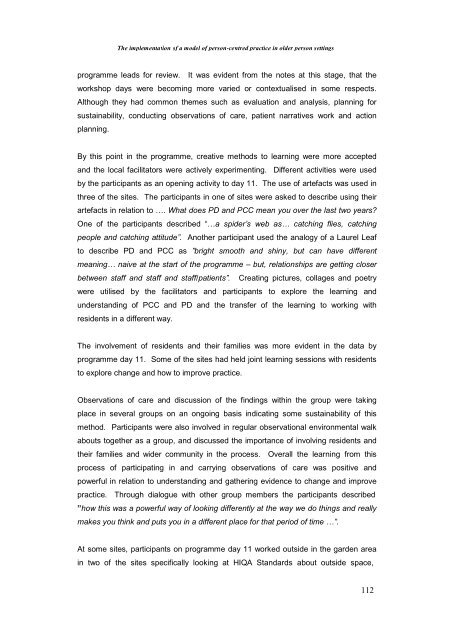The Implementation of a Model of Person-Centred Practice In Older ...
The Implementation of a Model of Person-Centred Practice In Older ...
The Implementation of a Model of Person-Centred Practice In Older ...
Create successful ePaper yourself
Turn your PDF publications into a flip-book with our unique Google optimized e-Paper software.
<strong>The</strong> implementation <strong>of</strong> a model <strong>of</strong> person-centred practice in older person settings<br />
programme leads for review. It was evident from the notes at this stage, that the<br />
workshop days were becoming more varied or contextualised in some respects.<br />
Although they had common themes such as evaluation and analysis, planning for<br />
sustainability, conducting observations <strong>of</strong> care, patient narratives work and action<br />
planning.<br />
By this point in the programme, creative methods to learning were more accepted<br />
and the local facilitators were actively experimenting. Different activities were used<br />
by the participants as an opening activity to day 11. <strong>The</strong> use <strong>of</strong> artefacts was used in<br />
three <strong>of</strong> the sites. <strong>The</strong> participants in one <strong>of</strong> sites were asked to describe using their<br />
artefacts in relation to …. What does PD and PCC mean you over the last two years?<br />
One <strong>of</strong> the participants described “…a spider’s web as… catching flies, catching<br />
people and catching attitude”. Another participant used the analogy <strong>of</strong> a Laurel Leaf<br />
to describe PD and PCC as ”bright smooth and shiny, but can have different<br />
meaning… naive at the start <strong>of</strong> the programme – but, relationships are getting closer<br />
between staff and staff and staff/patients”. Creating pictures, collages and poetry<br />
were utilised by the facilitators and participants to explore the learning and<br />
understanding <strong>of</strong> PCC and PD and the transfer <strong>of</strong> the learning to working with<br />
residents in a different way.<br />
<strong>The</strong> involvement <strong>of</strong> residents and their families was more evident in the data by<br />
programme day 11. Some <strong>of</strong> the sites had held joint learning sessions with residents<br />
to explore change and how to improve practice.<br />
Observations <strong>of</strong> care and discussion <strong>of</strong> the findings within the group were taking<br />
place in several groups on an ongoing basis indicating some sustainability <strong>of</strong> this<br />
method. Participants were also involved in regular observational environmental walk<br />
abouts together as a group, and discussed the importance <strong>of</strong> involving residents and<br />
their families and wider community in the process. Overall the learning from this<br />
process <strong>of</strong> participating in and carrying observations <strong>of</strong> care was positive and<br />
powerful in relation to understanding and gathering evidence to change and improve<br />
practice. Through dialogue with other group members the participants described<br />
”how this was a powerful way <strong>of</strong> looking differently at the way we do things and really<br />
makes you think and puts you in a different place for that period <strong>of</strong> time …”.<br />
At some sites, participants on programme day 11 worked outside in the garden area<br />
in two <strong>of</strong> the sites specifically looking at HIQA Standards about outside space,<br />
112
















